Unit 2 I think that mooncakes are delicious! 知识点讲解课件(共55张PPT)
文档属性
| 名称 | Unit 2 I think that mooncakes are delicious! 知识点讲解课件(共55张PPT) | 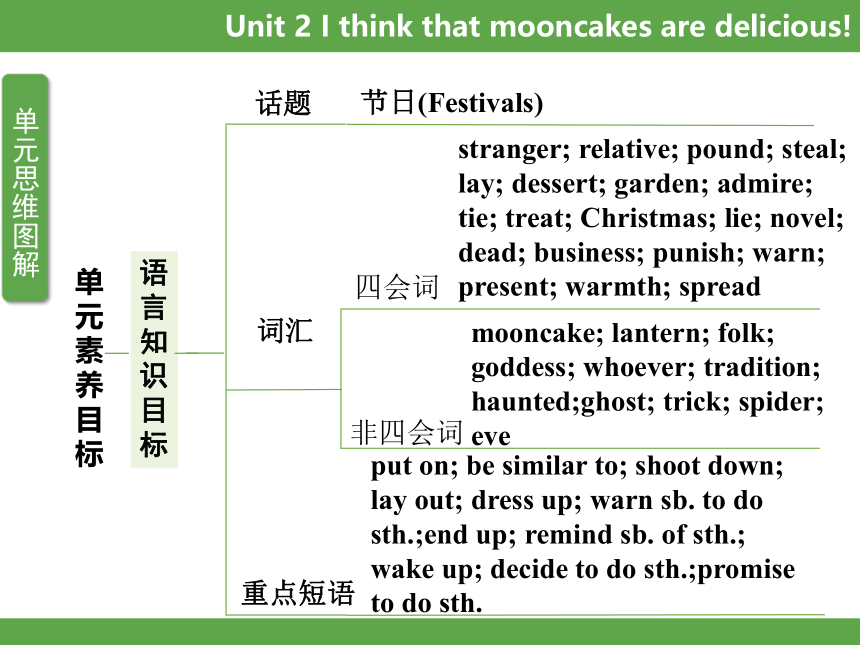 | |
| 格式 | pptx | ||
| 文件大小 | 363.6KB | ||
| 资源类型 | 教案 | ||
| 版本资源 | 人教新目标(Go for it)版 | ||
| 科目 | 英语 | ||
| 更新时间 | 2024-07-03 22:27:31 | ||
图片预览

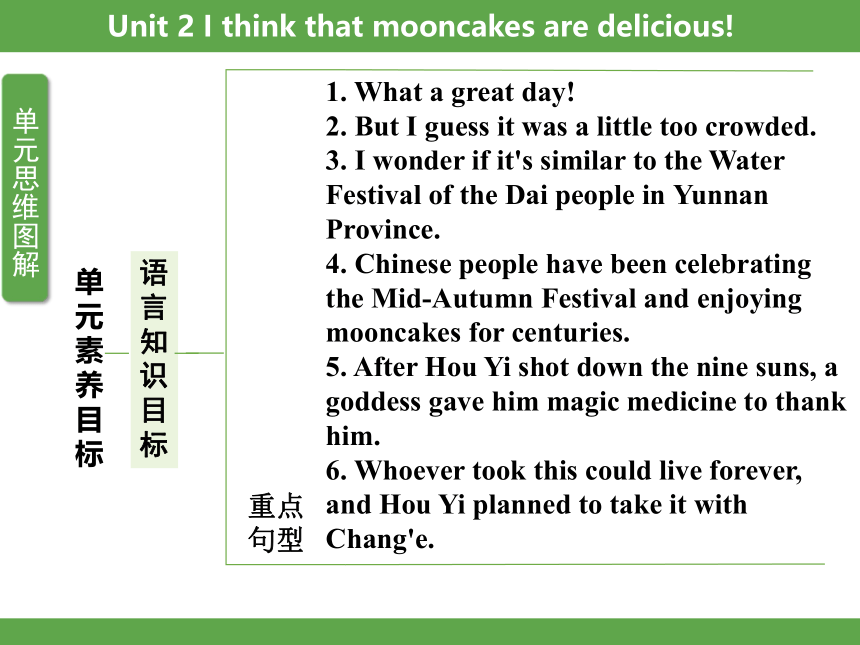
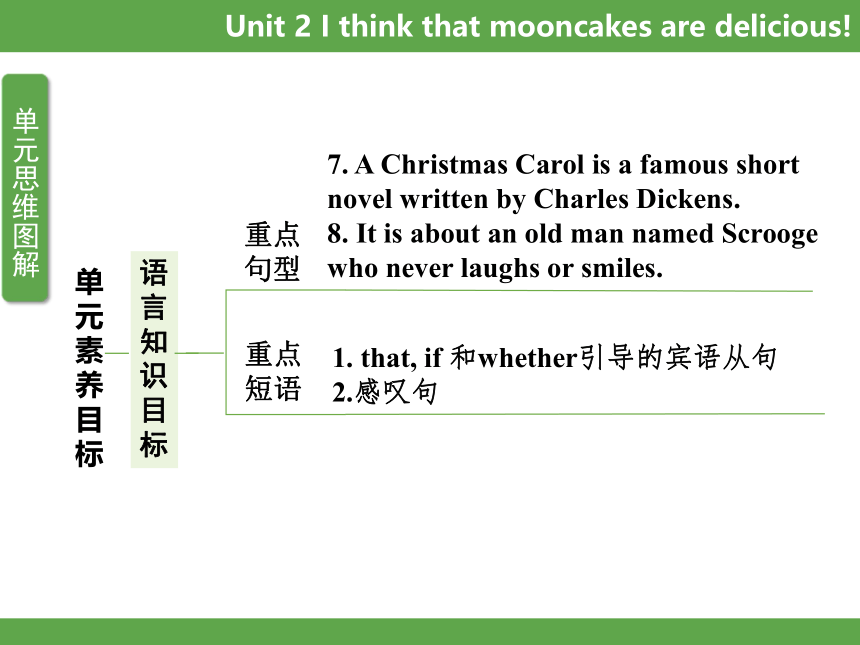
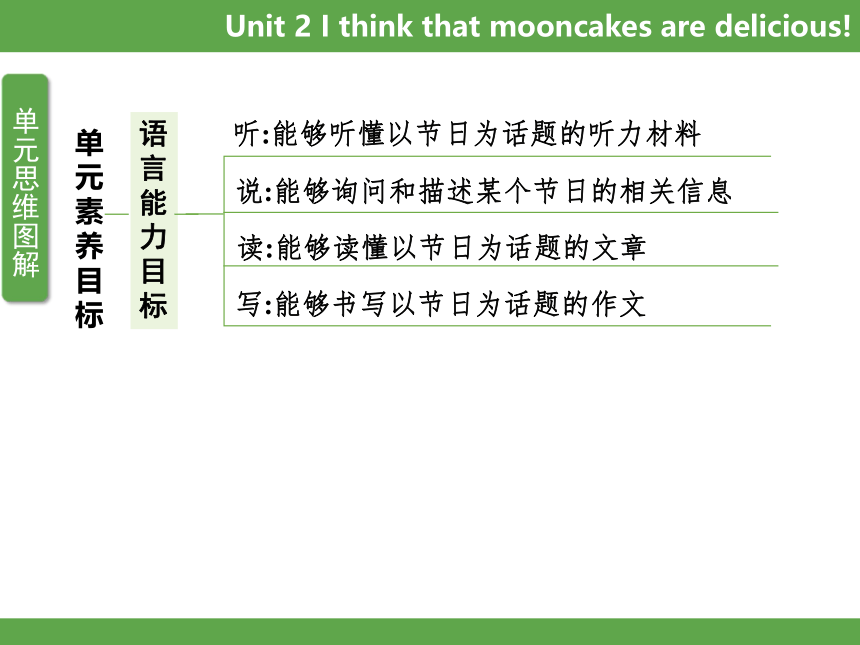
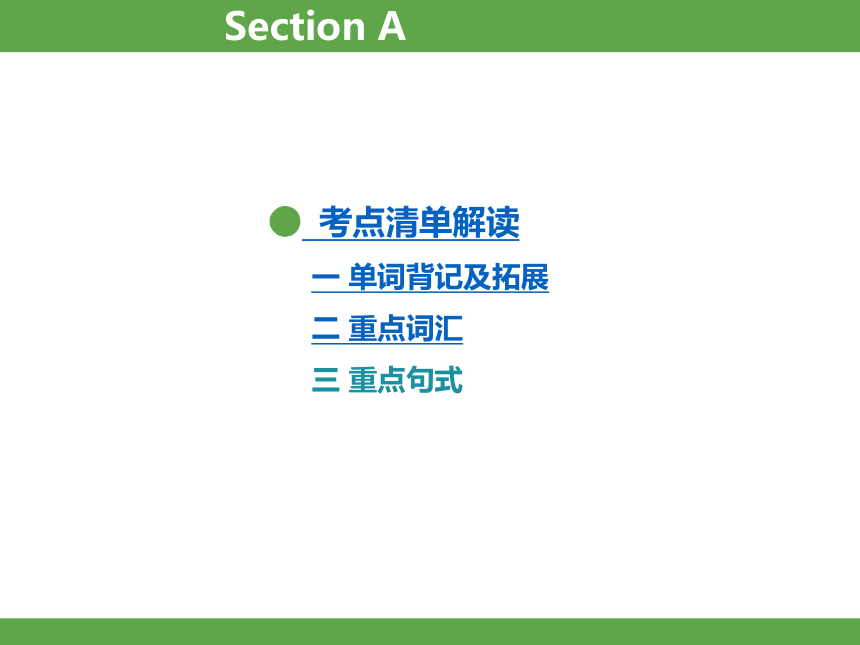
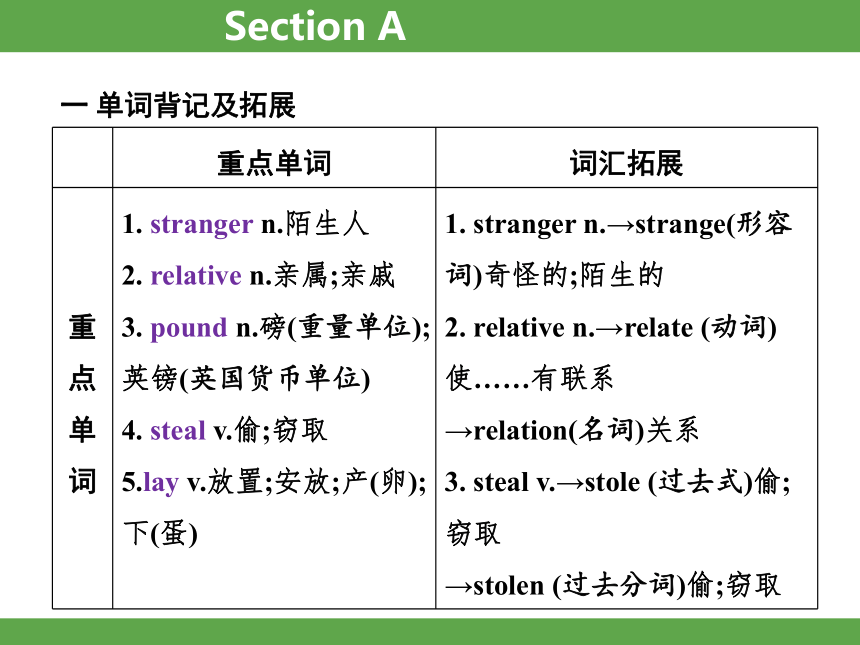
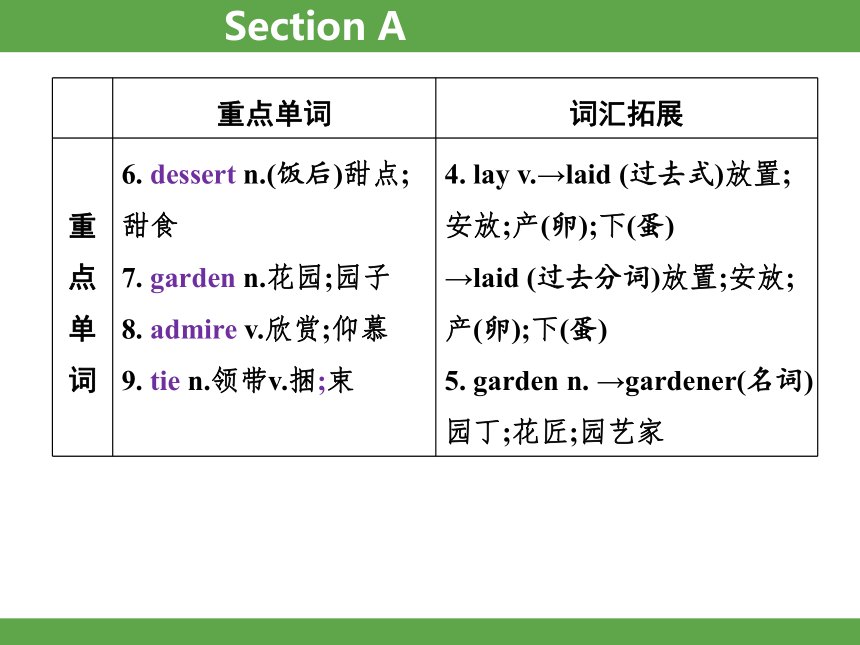
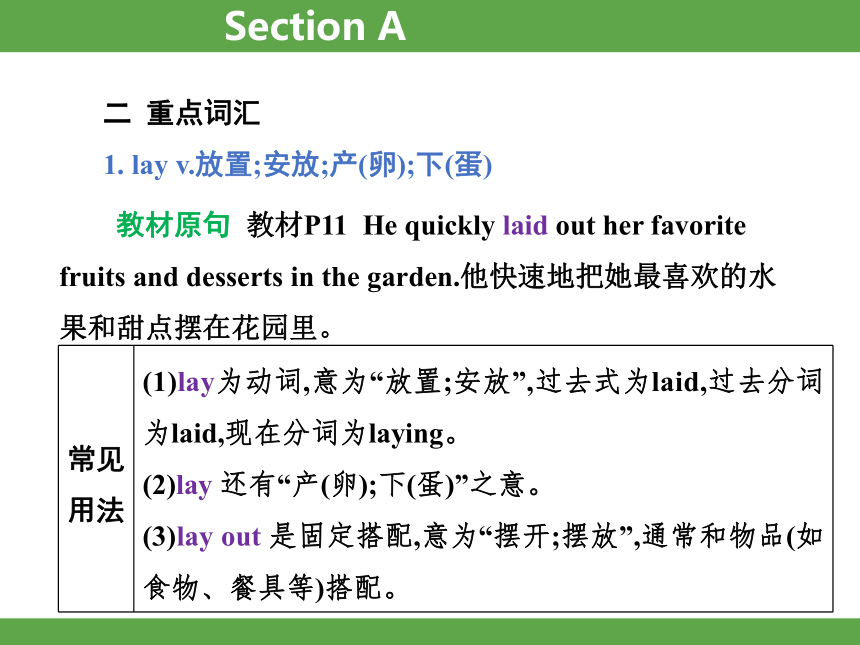
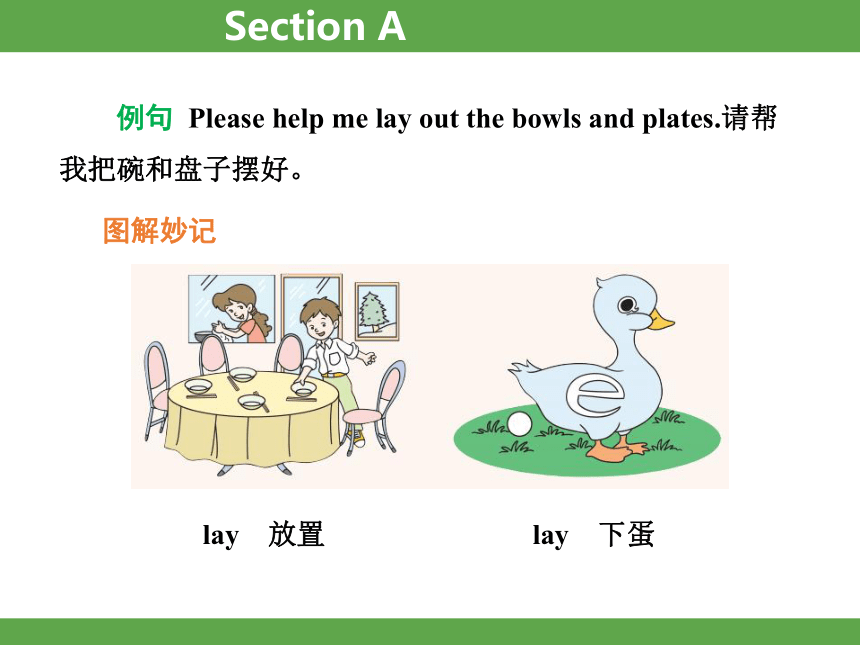
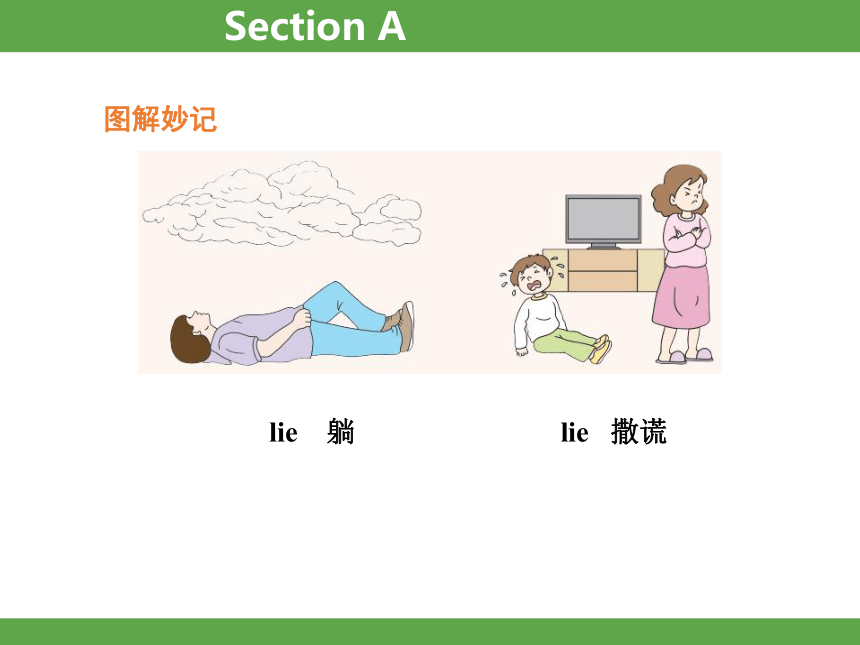
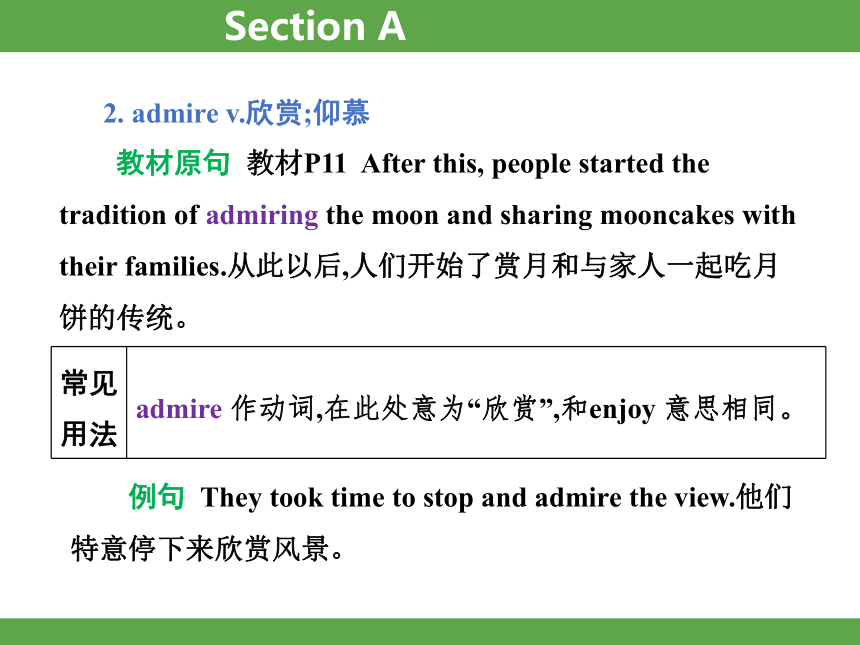
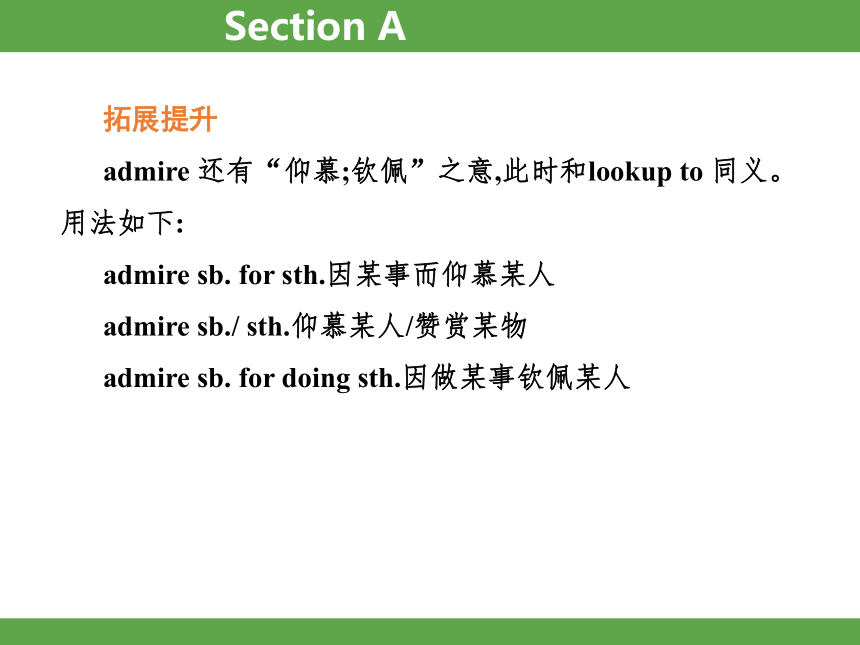
文档简介
(共55张PPT)
Unit 2 I think that mooncakes are delicious!
语
言
知识目
标
单元素养目标
词汇
话题
节日(Festivals)
四会词
stranger; relative; pound; steal; lay; dessert; garden; admire;
tie; treat; Christmas; lie; novel; dead; business; punish; warn;
present; warmth; spread
非四会词
mooncake; lantern; folk; goddess; whoever; tradition; haunted;ghost; trick; spider; eve
重点短语
put on; be similar to; shoot down; lay out; dress up; warn sb. to do sth.;end up; remind sb. of sth.; wake up; decide to do sth.;promise to do sth.
Unit 2 I think that mooncakes are delicious!
语
言
知识目
标
单元素养目标
1. What a great day!
2. But I guess it was a little too crowded.
3. I wonder if it's similar to the Water Festival of the Dai people in Yunnan Province.
4. Chinese people have been celebrating the Mid-Autumn Festival and enjoying mooncakes for centuries.
5. After Hou Yi shot down the nine suns, a goddess gave him magic medicine to thank him.
6. Whoever took this could live forever, and Hou Yi planned to take it with Chang'e.
重点
句型
Unit 2 I think that mooncakes are delicious!
语
言
知识目
标
单元素养目标
7. A Christmas Carol is a famous short novel written by Charles Dickens.
8. It is about an old man named Scrooge who never laughs or smiles.
重点
短语
1. that, if 和whether引导的宾语从句
2.感叹句
重点
句型
语言能力目标
单元素养目标
听:能够听懂以节日为话题的听力材料
说:能够询问和描述某个节日的相关信息
读:能够读懂以节日为话题的文章
写:能够书写以节日为话题的作文
Unit 2 I think that mooncakes are delicious!
● 考点清单解读
一 单词背记及拓展
二 重点词汇
三 重点句式
Section A
Section A
一 单词背记及拓展
重点单词 词汇拓展
重 点 单 词 1. stranger n.陌生人 2. relative n.亲属;亲戚 3. pound n.磅(重量单位);英镑(英国货币单位) 4. steal v.偷;窃取 5.lay v.放置;安放;产(卵);下(蛋) 1. stranger n.→strange(形容词)奇怪的;陌生的
2. relative n.→relate (动词)使……有联系
→relation(名词)关系
3. steal v.→stole (过去式)偷;窃取
→stolen (过去分词)偷;窃取
Section A
重点单词 词汇拓展
重 点 单 词 6. dessert n.(饭后)甜点;甜食 7. garden n.花园;园子 8. admire v.欣赏;仰慕 9. tie n.领带v.捆;束 4. lay v.→laid (过去式)放置;安放;产(卵);下(蛋)
→laid (过去分词)放置;安放;产(卵);下(蛋)
5. garden n. →gardener(名词)园丁;花匠;园艺家
Section A
二 重点词汇
1. lay v.放置;安放;产(卵);下(蛋)
教材原句 教材P11 He quickly laid out her favorite fruits and desserts in the garden.他快速地把她最喜欢的水果和甜点摆在花园里。
常见用法 (1)lay为动词,意为“放置;安放”,过去式为laid,过去分词为laid,现在分词为laying。
(2)lay 还有“产(卵);下(蛋)”之意。
(3)lay out 是固定搭配,意为“摆开;摆放”,通常和物品(如食物、餐具等)搭配。
Section A
例句 Please help me lay out the bowls and plates.请帮我把碗和盘子摆好。
图解妙记
lay 放置
lay 下蛋
Section A
图解妙记
lie 躺
lie 撒谎
Section A
2. admire v.欣赏;仰慕
教材原句 教材P11 After this, people started the tradition of admiring the moon and sharing mooncakes with their families.从此以后,人们开始了赏月和与家人一起吃月饼的传统。
例句 They took time to stop and admire the view.他们特意停下来欣赏风景。
常见用法 admire 作动词,在此处意为“欣赏”,和enjoy 意思相同。
Section A
拓展提升
admire 还有“仰慕;钦佩”之意,此时和lookup to 同义。用法如下:
admire sb. for sth.因某事而仰慕某人
admire sb./ sth.仰慕某人/赞赏某物
admire sb. for doing sth.因做某事钦佩某人
Section A
3. whoever pron.无论谁;不管什么人
教材原句 教材P11 Whoever took this could live forever,and Hou Yi planned to take it with Chang'e.无论谁吃下这个(药)都可以长生不老,于是后羿打算和嫦娥一起吃下它。
常见用法 whoever引导主语从句,相当于anyone who。
例句 Whoever comes here will be welcome. =Anyone who comes here will be welcome.无论谁来都会受到欢迎。
Section A
拓展提升
whoever 还 可引导让步状语从句,相当于no matter who。如:Whoever you are, I will not open the door.
=No matter who you are, I will not open the door. 不管你是谁,我都不会开门。
Section A
4. put on 增加(体重);发胖
教材原句 教材P10 I've put on five pounds!我重了五磅!
常见用法 本句中的put on 是固定搭配,意为“增加(体重);发胖”。另外,put on 还有如下含义:穿上;戴上;表演;演出。
例句 The girl ate too much and has put on three pounds.这个女孩吃得太多了,已经增重三磅。
You can put on your blue coat.
你可以穿上你的蓝色外套。
Section A
拓展提升
常见的 put短语还有:
put out 熄灭
put away把……收起来
put off 推迟
put down 放下;写下
put up 搭建;建造;张贴;
挂起;举起;抬起
Section A
三 重点句式
1.现在完成进行时
教材原句 教材P11 Chinese people have been celebrating the MidAutumn Festival and enjoying mooncakes for centuries.中国人庆祝中秋节、吃月饼已经有几个世纪了。
常见用法 本句时态为现在完成进行时,结构是“have/ has been+现在分词”。现在完成进行时表示动作从过去的某一时间开始,一直持续到现在,或者可能仍要继续下去。
Section A
例句 Jenny has been learning English since two years ago.自从两年前以来,珍妮一直在学英语。
易混辨析
现在完成时和一般过去时的易混辨析:两者表示的动作都发生在过去,但一般过去时的侧重点在于陈述过去发生的事情,与现在没有关系;现在完成时强调过去的动作对现在造成的影响或产生的结果,强调现在的情况。
Section A
2. one... the other...的用法
教材原句 教材P12 One is Mother's Day on the second Sunday of May, and the other is Father's Day on the third Sunday of June.一个在五月的第二个星期日,是母亲节,另一个在六月的第三个星期日,是父亲节。
常见用法 one... the other... 用来表示“两者中的一个……,另外一个……”。
例句 Lucy has two brothers. One is a worker, the other is a teacher.露西有两个哥哥。一个是一名工人,另一个是一名老师。
Section A
易混辨析
another, (the) other, others,the others
another 另外一个,用来修饰或代替单数可数名词,多指三者或三者以上中的另一个。
(the)other 别的,指两者中的另外那个。
others 表示不确定的“另一部分”,并非全部。
the others 表示“其余的全部”。
● 考点清单解读
一 单词背记及拓展
二 重点词汇
三 重点句式
四 重点语法
Section B
Section B
一 单词背记及拓展
重点单词 词汇拓展
重 点 单 词 1. treat n.款待;招待v.招待;请(客) 2. Christmas n.圣诞节 3. lie v.存在;平躺;处于 4. novel n.(长篇)小说 5. dead adj.死的;失去生命的 6. business n.生意;商业 1. treat v.→treated (过去式)招待;请(客)
→treated (过去分词)招待;请(客)
2.lie v.→lay(过去式)存在;平躺;处于
→lain (过去分词)存在;平躺;处于
3. dead adj.→die(动词)死;死亡
Section B
重点单词 词汇拓展
重 点 单 词 7. punish v.处罚;惩罚 8. warn v.警告;告诫 9. present n.现在;礼物 adj.现在的 10. warmth n.温暖;暖和 11. spread v.传播;展开 n.蔓延;传播 →death (名词)死;死亡
4. business n. →businessman(名词)商人
5. punish v. →punishment(名词)惩罚;处罚
6. warn v. →warning(名词)警告
7. warmth n. →warm (形容词)温暖的
Section B
熟词生义
business 还可意为“商业机构;企业”。
Section B
二 重点词汇
1. treat n.款待;招待v.招待;请(客)
教材原句 教材P13 Trick or treat”means kids will play a trick on you if you don't give them a treat.“不招待就捣乱”意思是如果你不招待他们,孩子们就会对你搞恶作剧。
例句 She treated him to lunch.她请他吃午饭。
常见用法 treat 作名词,意为“款待;招待”;作动词,意为“招待;请(客)”。常见搭配:treat sb. to sth.意为“用……招待某人;以……款待某人”。
Section B
拓展提升
treat 作动词的其他常见含义及用法:
(1)意为“把……视为;以……态度对待”。其常用结构为:
treat... as... 把……视为·……;
treat... with... 以……态度对待……
(2)意为“医治;治疗”,常见搭配:treat sb. (for...) (with...)(用…)治疗某人(的……)
Section B
2. dead adj.死的;失去生命的
教材原句 教材P14 One Christmas Eve, Scrooge sees the ghost of Jacob Marley, his dead business partner.一个圣诞节前夜,斯克鲁奇看到了他死去的生意伙伴雅各布·马利的灵魂。
例句 His father has been dead for five years.他的父亲已经去世五年了。
常见用法 dead 为形容词,意为“死的;失去生命的”,表示状态,可以与表示一段时间的状语连用,若表达“去世多长时间了”,则用“have/has been dead for+时间段”。
Section B
易混辨析
dead,die,death与 dying 的用法区别:
(1)dead为形容词,常与be动词连用,表示死的状态。
(2)die 为动词,意为“死亡”,指生命的结束,强调动作。
(3)death 是 die 的名词形式,意为“死;死亡”。
(4)dying是die 的现在分词,常用作形容词,意为“临死的;垂死的”。
Section B
3. warn v.警告;告诫end up 最终成为;最后处于
教材原句 教材P14 He warns Scrooge to change his ways if he doesn't want to end up like him.他警告斯克鲁奇,如果他不想最后成为像他一样的人,就要改变他的行事方式。
常见用法 warn 作动词,意为“警告;告诫”,常用于以下结构中:
warn sb.提醒某人;warn (sb.) that...提醒(某人)……;warn (sb.) of sth.提醒(某人)某事;warn sb. (not) to do sth.警告某人(不要)做某事;warn (sb.) against doing sth.告诫/警告(某人)不要做某事。
Section B
例句 We warned the children not to walk on the thin ice.我们告诫孩子们不要在薄冰上行走。
常见用法 end up 是固定搭配,意为“最终成为;最后处于”,end up后若跟动词,只能跟动名词。
例句 I ended up doing all the work by myself.结果所有的活儿都让我一个人干了。
Section B
拓展提升
常见的“动词+up”结构的短语
grow up 长大 take up占用
get up 起床 give up 放弃
pick up 拾起;捡起 stay up 熬夜
use up 用完;耗尽 tidy up 收拾;整理
clean up 打扫 干净 look up查阅;向上看
wake up 醒来
Section B
4. punish v.处罚;惩罚
教材原句 教材P14 Marley used to be just like Scrooge, so he was punished after he died.马利曾经就像斯克鲁奇一样,所以他死后受到了惩罚。
常见用法 punish 是及物动词,意为“处罚;惩罚”。punish sb. for (doing) sth.因(做)某事而处罚某人
例句 You'll be punished if you drive after drinking wine.如果你酒后驾驶,你将会受到惩罚。
Section B
易错提示
punish 多以被动语态的形式考查。“am/is/ are/was/ were punished”表 示“被惩罚”。
拓展提升
punishment 为名词,意为“惩罚;处罚”。
Section B
5. remind sb. of sth.使某人想起某事;提醒某人某事
教材原句 教材P14 First,the Ghost of Christmas Past takes him back to his childhood and reminds Scrooge of his happier days as a child.首先,“过去之灵”带斯克鲁奇回到了他的童年,使他想起了孩提时的快乐时光。
常见用法 remind 意为“提醒;使想起”,remind sb. of sth.意为“使某人想起某事;提醒某人某事”。
例句 I must remind you of your promise.我必须提醒你你答应过的事。
Section B
拓展提升
(1)remind sb. todo sth. 意为“提醒某人做某事”。如:Don't forget to remind your elder brother to come here on time.不要忘记提醒你哥哥按时到这里。
(2)remind sb.+that 从句,意为“提醒某人……”。如:I remind him that he must go home before dark.我提醒他必须在天黑之前回家。
Section B
6. promise to do sth.承诺做某事
教材原句 教材P14 He decides to change his life and promises to be a better person.他决定改变他的生活方式并承诺成为更好的人。
常见用法 promise to do sth.意为“承诺做某事”。其中promise用作动词,意为“承诺”,其他用法还有:
promisesb.sth.意为“承诺某人某事”;promise+that从句,意为“承诺……”。
例句 I promise that we can work out the problem at last.我承诺最后我们一定能解决这个问题。
Section B
拓展提升
promise 还可作名词,意为“承诺;诺言”。常用于以下搭配:make/ keep/ break a promise许下/ 信守/违背诺言如:Give me your promise that you'll never be late again,please. 请答应我你绝不会再迟到了。
Section B
三 重点句式
not only... but also...不但……而且……
教材原句 教材P6 Not only do people spread them around in different hiding places for an egg hunt, but they also give out these treats as gifts.人们不仅把它们分散在不同的地方,供找蛋游戏用,而且他们还会分发这些好吃的作为礼物。
Section B
常见用法 not only... but also...在本句中连接两个并列分句,not only 可放在句首,表示强调,此时句子要用部分倒装结构,即将谓语的一部分(如情态动词、be动词、助动词等)放在主语的前面,而but also后的句子不倒装。
例句 Not only did he say so, but also he did so.他不仅这样说,也这样做了。
Not only you but also Jack has been to the Great Wall.不仅你,杰克也去过长城。
Section B
易错提示
not only... but also...连接并列成分作主语时,句子的谓语动词应与but also后的主语在人称和数上保持一致,即遵循就近一致原则。
Section B
四 重点语法
1. that, if 和 whether 引导的宾语从句
在主从复合句中起宾语作用的从句叫作宾语从句。在含有宾语从句的复合句中,从句要用陈述语序。
常见用法 此处含that引导的宾语从句,当宾语从句由陈述句变化而来的时候,用that引导从句,that无具体意义,一般可以省略。宾语从句有时用形式宾语it代替,而把从句后置,此时that不能省略。
(1)教材原句 教材P12 I know that the Water Festival is really fun.我知道泼水节很有趣。
Section B
例句 She told me (that) she would like to go with us.她告诉我她想和我们一起去。
We have made it clear that we will learn to deal with various difficult problems.我们已经表明,我们将学会处理各种难题。
Section B
易混辨析
有些情况下只能用whether,不能用if:
(1)在不定式前或介词之后引导宾语从句时;
(2)与 or not直接连用时;
(3)用if 会引起歧义时。如:Her father is worried about whether he will lose his work.她父亲担心自己是否会失业。We didn't know whether or not she was ready.我们不知道她是否准备好了。
Section B
常见用法 此处含whether/if引导的宾语从句,当宾语从句由一般疑问句变化而来时,可用whether或if引导从句。有时二者可通用,但whether一般用于比较正式的场合,if多用于口语。
(2)教材原句 教材P12 I wonder if they'll have the races again next year.我想知道他们明年是否还会举行比赛。
教材P12 I wonder whether June is a good time to visit Hong Kong.我想知道六月是不是游览香港的好时间。
Section B
例句 He couldn't tell if/ whether she was laughing or crying.他不能分辨出她是在笑还是在哭。
I wonder whether I should wear a coat or not.我不知道是否该穿外套。
Section B
小助记
宾语从句的用法
宾语从句引导词,不同句子各相异。
陈述句子用that,一般疑问“是否(if/whether)”替。
主句若为现在时,从句时态可随意。
主句若为过去时,从句时态多过去。
句子语序要记清,从句永保陈述序。
Section B
2.感叹句
常见用法 用来表示喜、怒、哀、乐等感彩的句子叫作感叹句。感叹句通常用what,how引导,句末用感叹号。what修饰名词,how修饰形容词或副词。
(1)由what 引导的感叹句的构成:
①What+a/an+形容词+可数名词单数+主语+谓语!
教材原句 教材P12 How pretty the dragon boats were!龙舟多漂亮啊!
例句 What a beautiful flower it is!多么漂亮的一朵花啊!
Section B
②What+形容词+可数名词复数形式/不可数名词+主语+谓语!
例句 What fine weather it is today!今天的天气真好!
(2)由how 引导的感叹句的构成:
①How+形容词/副词+主语+谓语!
例句 How hard they work!他们工作多么努力啊!
②How+形容词+a/an+可数名词单数+主语+谓语!
例句 How heavy a box they are carrying!他们抬的箱子多重啊!
③How+主语+谓语!
例句 How time flies!光阴似箭!
Section B
拓展提升
what 引导的感叹句通常可以与how 引导的感叹句进行转换。如:What a lovely girl she is! =How lovely a girl she is!她是多么可爱的一个女孩啊!
Section B
小助记
感叹句,并不难,
what与 how 应在前。
形容词、副词跟着how,
what 后面名词连。
名词若是可数单,
前面冠词a或an。
主语、谓语放后面,
省略它们也常见。
语篇考法精讲
句子还原题解题技巧
典例剖析
Niangao is usually made from glutinous rice flour(糯米粉),wheat starch(小麦淀粉),salt, water and sugar. The tastes can be divided into two main kinds: sweet niangao in northern China, while sweet or salty niangao in the south. Salty and sweet tastes are both fantastic. In the Jiangsu and Zhejiang areas, people can put different things inside niangao, such as flower sugar, oil, and sweet red beans.
语篇考法精讲
_______The ways to make niangao include braise(炖),stir-fry(炒),deep-fry, piece-fry, soup cooks and so on. Stir-fried niangao with sugar is quite popular. ...
[中考新考法·句子还原]
Which of the following sentences can be put in the “____”
A. Niangao is the most delicious traditional food.
B. Niangao is popular with all the young people.
C. People cook niangao in many different ways.
D. People like giving niangao to friends on holidays.
语篇考法精讲
[解析]根据“The ways to make niangao include braise, stir-fry, deep-fry, piece-fry, soup cooks and so on. Stir-fried niangao with sugar is quite popular.”可知,年糕的制作方法有炖、炒、炸、片炒、煮汤等。糖炒年糕很受欢迎。所以本段介绍的是年糕的烹饪方法有很多,故选C。
[答案] C
语篇考法精讲
考法说明
中考阅读理解对句子还原题的考查主要涉及:主旨概括性句子、过渡性句子、注释性句子等。设空位置包括段首、段中和段尾。
语篇考法精讲
技巧点拨
1.段首设空。通常是段落的主题句,是对后文的总结概括或者段落间的过渡句,要关注前一段的尾句与本段的关系。
2.段中设空。结合设空前后句内容,关注连词、代词、序数词等。
3.段尾设空。对设空前两句重点阅读,明确全段内容。可在选项中查找表示结果的信号词;重点阅读下段前两句,明确下段内容。
Unit 2 I think that mooncakes are delicious!
语
言
知识目
标
单元素养目标
词汇
话题
节日(Festivals)
四会词
stranger; relative; pound; steal; lay; dessert; garden; admire;
tie; treat; Christmas; lie; novel; dead; business; punish; warn;
present; warmth; spread
非四会词
mooncake; lantern; folk; goddess; whoever; tradition; haunted;ghost; trick; spider; eve
重点短语
put on; be similar to; shoot down; lay out; dress up; warn sb. to do sth.;end up; remind sb. of sth.; wake up; decide to do sth.;promise to do sth.
Unit 2 I think that mooncakes are delicious!
语
言
知识目
标
单元素养目标
1. What a great day!
2. But I guess it was a little too crowded.
3. I wonder if it's similar to the Water Festival of the Dai people in Yunnan Province.
4. Chinese people have been celebrating the Mid-Autumn Festival and enjoying mooncakes for centuries.
5. After Hou Yi shot down the nine suns, a goddess gave him magic medicine to thank him.
6. Whoever took this could live forever, and Hou Yi planned to take it with Chang'e.
重点
句型
Unit 2 I think that mooncakes are delicious!
语
言
知识目
标
单元素养目标
7. A Christmas Carol is a famous short novel written by Charles Dickens.
8. It is about an old man named Scrooge who never laughs or smiles.
重点
短语
1. that, if 和whether引导的宾语从句
2.感叹句
重点
句型
语言能力目标
单元素养目标
听:能够听懂以节日为话题的听力材料
说:能够询问和描述某个节日的相关信息
读:能够读懂以节日为话题的文章
写:能够书写以节日为话题的作文
Unit 2 I think that mooncakes are delicious!
● 考点清单解读
一 单词背记及拓展
二 重点词汇
三 重点句式
Section A
Section A
一 单词背记及拓展
重点单词 词汇拓展
重 点 单 词 1. stranger n.陌生人 2. relative n.亲属;亲戚 3. pound n.磅(重量单位);英镑(英国货币单位) 4. steal v.偷;窃取 5.lay v.放置;安放;产(卵);下(蛋) 1. stranger n.→strange(形容词)奇怪的;陌生的
2. relative n.→relate (动词)使……有联系
→relation(名词)关系
3. steal v.→stole (过去式)偷;窃取
→stolen (过去分词)偷;窃取
Section A
重点单词 词汇拓展
重 点 单 词 6. dessert n.(饭后)甜点;甜食 7. garden n.花园;园子 8. admire v.欣赏;仰慕 9. tie n.领带v.捆;束 4. lay v.→laid (过去式)放置;安放;产(卵);下(蛋)
→laid (过去分词)放置;安放;产(卵);下(蛋)
5. garden n. →gardener(名词)园丁;花匠;园艺家
Section A
二 重点词汇
1. lay v.放置;安放;产(卵);下(蛋)
教材原句 教材P11 He quickly laid out her favorite fruits and desserts in the garden.他快速地把她最喜欢的水果和甜点摆在花园里。
常见用法 (1)lay为动词,意为“放置;安放”,过去式为laid,过去分词为laid,现在分词为laying。
(2)lay 还有“产(卵);下(蛋)”之意。
(3)lay out 是固定搭配,意为“摆开;摆放”,通常和物品(如食物、餐具等)搭配。
Section A
例句 Please help me lay out the bowls and plates.请帮我把碗和盘子摆好。
图解妙记
lay 放置
lay 下蛋
Section A
图解妙记
lie 躺
lie 撒谎
Section A
2. admire v.欣赏;仰慕
教材原句 教材P11 After this, people started the tradition of admiring the moon and sharing mooncakes with their families.从此以后,人们开始了赏月和与家人一起吃月饼的传统。
例句 They took time to stop and admire the view.他们特意停下来欣赏风景。
常见用法 admire 作动词,在此处意为“欣赏”,和enjoy 意思相同。
Section A
拓展提升
admire 还有“仰慕;钦佩”之意,此时和lookup to 同义。用法如下:
admire sb. for sth.因某事而仰慕某人
admire sb./ sth.仰慕某人/赞赏某物
admire sb. for doing sth.因做某事钦佩某人
Section A
3. whoever pron.无论谁;不管什么人
教材原句 教材P11 Whoever took this could live forever,and Hou Yi planned to take it with Chang'e.无论谁吃下这个(药)都可以长生不老,于是后羿打算和嫦娥一起吃下它。
常见用法 whoever引导主语从句,相当于anyone who。
例句 Whoever comes here will be welcome. =Anyone who comes here will be welcome.无论谁来都会受到欢迎。
Section A
拓展提升
whoever 还 可引导让步状语从句,相当于no matter who。如:Whoever you are, I will not open the door.
=No matter who you are, I will not open the door. 不管你是谁,我都不会开门。
Section A
4. put on 增加(体重);发胖
教材原句 教材P10 I've put on five pounds!我重了五磅!
常见用法 本句中的put on 是固定搭配,意为“增加(体重);发胖”。另外,put on 还有如下含义:穿上;戴上;表演;演出。
例句 The girl ate too much and has put on three pounds.这个女孩吃得太多了,已经增重三磅。
You can put on your blue coat.
你可以穿上你的蓝色外套。
Section A
拓展提升
常见的 put短语还有:
put out 熄灭
put away把……收起来
put off 推迟
put down 放下;写下
put up 搭建;建造;张贴;
挂起;举起;抬起
Section A
三 重点句式
1.现在完成进行时
教材原句 教材P11 Chinese people have been celebrating the MidAutumn Festival and enjoying mooncakes for centuries.中国人庆祝中秋节、吃月饼已经有几个世纪了。
常见用法 本句时态为现在完成进行时,结构是“have/ has been+现在分词”。现在完成进行时表示动作从过去的某一时间开始,一直持续到现在,或者可能仍要继续下去。
Section A
例句 Jenny has been learning English since two years ago.自从两年前以来,珍妮一直在学英语。
易混辨析
现在完成时和一般过去时的易混辨析:两者表示的动作都发生在过去,但一般过去时的侧重点在于陈述过去发生的事情,与现在没有关系;现在完成时强调过去的动作对现在造成的影响或产生的结果,强调现在的情况。
Section A
2. one... the other...的用法
教材原句 教材P12 One is Mother's Day on the second Sunday of May, and the other is Father's Day on the third Sunday of June.一个在五月的第二个星期日,是母亲节,另一个在六月的第三个星期日,是父亲节。
常见用法 one... the other... 用来表示“两者中的一个……,另外一个……”。
例句 Lucy has two brothers. One is a worker, the other is a teacher.露西有两个哥哥。一个是一名工人,另一个是一名老师。
Section A
易混辨析
another, (the) other, others,the others
another 另外一个,用来修饰或代替单数可数名词,多指三者或三者以上中的另一个。
(the)other 别的,指两者中的另外那个。
others 表示不确定的“另一部分”,并非全部。
the others 表示“其余的全部”。
● 考点清单解读
一 单词背记及拓展
二 重点词汇
三 重点句式
四 重点语法
Section B
Section B
一 单词背记及拓展
重点单词 词汇拓展
重 点 单 词 1. treat n.款待;招待v.招待;请(客) 2. Christmas n.圣诞节 3. lie v.存在;平躺;处于 4. novel n.(长篇)小说 5. dead adj.死的;失去生命的 6. business n.生意;商业 1. treat v.→treated (过去式)招待;请(客)
→treated (过去分词)招待;请(客)
2.lie v.→lay(过去式)存在;平躺;处于
→lain (过去分词)存在;平躺;处于
3. dead adj.→die(动词)死;死亡
Section B
重点单词 词汇拓展
重 点 单 词 7. punish v.处罚;惩罚 8. warn v.警告;告诫 9. present n.现在;礼物 adj.现在的 10. warmth n.温暖;暖和 11. spread v.传播;展开 n.蔓延;传播 →death (名词)死;死亡
4. business n. →businessman(名词)商人
5. punish v. →punishment(名词)惩罚;处罚
6. warn v. →warning(名词)警告
7. warmth n. →warm (形容词)温暖的
Section B
熟词生义
business 还可意为“商业机构;企业”。
Section B
二 重点词汇
1. treat n.款待;招待v.招待;请(客)
教材原句 教材P13 Trick or treat”means kids will play a trick on you if you don't give them a treat.“不招待就捣乱”意思是如果你不招待他们,孩子们就会对你搞恶作剧。
例句 She treated him to lunch.她请他吃午饭。
常见用法 treat 作名词,意为“款待;招待”;作动词,意为“招待;请(客)”。常见搭配:treat sb. to sth.意为“用……招待某人;以……款待某人”。
Section B
拓展提升
treat 作动词的其他常见含义及用法:
(1)意为“把……视为;以……态度对待”。其常用结构为:
treat... as... 把……视为·……;
treat... with... 以……态度对待……
(2)意为“医治;治疗”,常见搭配:treat sb. (for...) (with...)(用…)治疗某人(的……)
Section B
2. dead adj.死的;失去生命的
教材原句 教材P14 One Christmas Eve, Scrooge sees the ghost of Jacob Marley, his dead business partner.一个圣诞节前夜,斯克鲁奇看到了他死去的生意伙伴雅各布·马利的灵魂。
例句 His father has been dead for five years.他的父亲已经去世五年了。
常见用法 dead 为形容词,意为“死的;失去生命的”,表示状态,可以与表示一段时间的状语连用,若表达“去世多长时间了”,则用“have/has been dead for+时间段”。
Section B
易混辨析
dead,die,death与 dying 的用法区别:
(1)dead为形容词,常与be动词连用,表示死的状态。
(2)die 为动词,意为“死亡”,指生命的结束,强调动作。
(3)death 是 die 的名词形式,意为“死;死亡”。
(4)dying是die 的现在分词,常用作形容词,意为“临死的;垂死的”。
Section B
3. warn v.警告;告诫end up 最终成为;最后处于
教材原句 教材P14 He warns Scrooge to change his ways if he doesn't want to end up like him.他警告斯克鲁奇,如果他不想最后成为像他一样的人,就要改变他的行事方式。
常见用法 warn 作动词,意为“警告;告诫”,常用于以下结构中:
warn sb.提醒某人;warn (sb.) that...提醒(某人)……;warn (sb.) of sth.提醒(某人)某事;warn sb. (not) to do sth.警告某人(不要)做某事;warn (sb.) against doing sth.告诫/警告(某人)不要做某事。
Section B
例句 We warned the children not to walk on the thin ice.我们告诫孩子们不要在薄冰上行走。
常见用法 end up 是固定搭配,意为“最终成为;最后处于”,end up后若跟动词,只能跟动名词。
例句 I ended up doing all the work by myself.结果所有的活儿都让我一个人干了。
Section B
拓展提升
常见的“动词+up”结构的短语
grow up 长大 take up占用
get up 起床 give up 放弃
pick up 拾起;捡起 stay up 熬夜
use up 用完;耗尽 tidy up 收拾;整理
clean up 打扫 干净 look up查阅;向上看
wake up 醒来
Section B
4. punish v.处罚;惩罚
教材原句 教材P14 Marley used to be just like Scrooge, so he was punished after he died.马利曾经就像斯克鲁奇一样,所以他死后受到了惩罚。
常见用法 punish 是及物动词,意为“处罚;惩罚”。punish sb. for (doing) sth.因(做)某事而处罚某人
例句 You'll be punished if you drive after drinking wine.如果你酒后驾驶,你将会受到惩罚。
Section B
易错提示
punish 多以被动语态的形式考查。“am/is/ are/was/ were punished”表 示“被惩罚”。
拓展提升
punishment 为名词,意为“惩罚;处罚”。
Section B
5. remind sb. of sth.使某人想起某事;提醒某人某事
教材原句 教材P14 First,the Ghost of Christmas Past takes him back to his childhood and reminds Scrooge of his happier days as a child.首先,“过去之灵”带斯克鲁奇回到了他的童年,使他想起了孩提时的快乐时光。
常见用法 remind 意为“提醒;使想起”,remind sb. of sth.意为“使某人想起某事;提醒某人某事”。
例句 I must remind you of your promise.我必须提醒你你答应过的事。
Section B
拓展提升
(1)remind sb. todo sth. 意为“提醒某人做某事”。如:Don't forget to remind your elder brother to come here on time.不要忘记提醒你哥哥按时到这里。
(2)remind sb.+that 从句,意为“提醒某人……”。如:I remind him that he must go home before dark.我提醒他必须在天黑之前回家。
Section B
6. promise to do sth.承诺做某事
教材原句 教材P14 He decides to change his life and promises to be a better person.他决定改变他的生活方式并承诺成为更好的人。
常见用法 promise to do sth.意为“承诺做某事”。其中promise用作动词,意为“承诺”,其他用法还有:
promisesb.sth.意为“承诺某人某事”;promise+that从句,意为“承诺……”。
例句 I promise that we can work out the problem at last.我承诺最后我们一定能解决这个问题。
Section B
拓展提升
promise 还可作名词,意为“承诺;诺言”。常用于以下搭配:make/ keep/ break a promise许下/ 信守/违背诺言如:Give me your promise that you'll never be late again,please. 请答应我你绝不会再迟到了。
Section B
三 重点句式
not only... but also...不但……而且……
教材原句 教材P6 Not only do people spread them around in different hiding places for an egg hunt, but they also give out these treats as gifts.人们不仅把它们分散在不同的地方,供找蛋游戏用,而且他们还会分发这些好吃的作为礼物。
Section B
常见用法 not only... but also...在本句中连接两个并列分句,not only 可放在句首,表示强调,此时句子要用部分倒装结构,即将谓语的一部分(如情态动词、be动词、助动词等)放在主语的前面,而but also后的句子不倒装。
例句 Not only did he say so, but also he did so.他不仅这样说,也这样做了。
Not only you but also Jack has been to the Great Wall.不仅你,杰克也去过长城。
Section B
易错提示
not only... but also...连接并列成分作主语时,句子的谓语动词应与but also后的主语在人称和数上保持一致,即遵循就近一致原则。
Section B
四 重点语法
1. that, if 和 whether 引导的宾语从句
在主从复合句中起宾语作用的从句叫作宾语从句。在含有宾语从句的复合句中,从句要用陈述语序。
常见用法 此处含that引导的宾语从句,当宾语从句由陈述句变化而来的时候,用that引导从句,that无具体意义,一般可以省略。宾语从句有时用形式宾语it代替,而把从句后置,此时that不能省略。
(1)教材原句 教材P12 I know that the Water Festival is really fun.我知道泼水节很有趣。
Section B
例句 She told me (that) she would like to go with us.她告诉我她想和我们一起去。
We have made it clear that we will learn to deal with various difficult problems.我们已经表明,我们将学会处理各种难题。
Section B
易混辨析
有些情况下只能用whether,不能用if:
(1)在不定式前或介词之后引导宾语从句时;
(2)与 or not直接连用时;
(3)用if 会引起歧义时。如:Her father is worried about whether he will lose his work.她父亲担心自己是否会失业。We didn't know whether or not she was ready.我们不知道她是否准备好了。
Section B
常见用法 此处含whether/if引导的宾语从句,当宾语从句由一般疑问句变化而来时,可用whether或if引导从句。有时二者可通用,但whether一般用于比较正式的场合,if多用于口语。
(2)教材原句 教材P12 I wonder if they'll have the races again next year.我想知道他们明年是否还会举行比赛。
教材P12 I wonder whether June is a good time to visit Hong Kong.我想知道六月是不是游览香港的好时间。
Section B
例句 He couldn't tell if/ whether she was laughing or crying.他不能分辨出她是在笑还是在哭。
I wonder whether I should wear a coat or not.我不知道是否该穿外套。
Section B
小助记
宾语从句的用法
宾语从句引导词,不同句子各相异。
陈述句子用that,一般疑问“是否(if/whether)”替。
主句若为现在时,从句时态可随意。
主句若为过去时,从句时态多过去。
句子语序要记清,从句永保陈述序。
Section B
2.感叹句
常见用法 用来表示喜、怒、哀、乐等感彩的句子叫作感叹句。感叹句通常用what,how引导,句末用感叹号。what修饰名词,how修饰形容词或副词。
(1)由what 引导的感叹句的构成:
①What+a/an+形容词+可数名词单数+主语+谓语!
教材原句 教材P12 How pretty the dragon boats were!龙舟多漂亮啊!
例句 What a beautiful flower it is!多么漂亮的一朵花啊!
Section B
②What+形容词+可数名词复数形式/不可数名词+主语+谓语!
例句 What fine weather it is today!今天的天气真好!
(2)由how 引导的感叹句的构成:
①How+形容词/副词+主语+谓语!
例句 How hard they work!他们工作多么努力啊!
②How+形容词+a/an+可数名词单数+主语+谓语!
例句 How heavy a box they are carrying!他们抬的箱子多重啊!
③How+主语+谓语!
例句 How time flies!光阴似箭!
Section B
拓展提升
what 引导的感叹句通常可以与how 引导的感叹句进行转换。如:What a lovely girl she is! =How lovely a girl she is!她是多么可爱的一个女孩啊!
Section B
小助记
感叹句,并不难,
what与 how 应在前。
形容词、副词跟着how,
what 后面名词连。
名词若是可数单,
前面冠词a或an。
主语、谓语放后面,
省略它们也常见。
语篇考法精讲
句子还原题解题技巧
典例剖析
Niangao is usually made from glutinous rice flour(糯米粉),wheat starch(小麦淀粉),salt, water and sugar. The tastes can be divided into two main kinds: sweet niangao in northern China, while sweet or salty niangao in the south. Salty and sweet tastes are both fantastic. In the Jiangsu and Zhejiang areas, people can put different things inside niangao, such as flower sugar, oil, and sweet red beans.
语篇考法精讲
_______The ways to make niangao include braise(炖),stir-fry(炒),deep-fry, piece-fry, soup cooks and so on. Stir-fried niangao with sugar is quite popular. ...
[中考新考法·句子还原]
Which of the following sentences can be put in the “____”
A. Niangao is the most delicious traditional food.
B. Niangao is popular with all the young people.
C. People cook niangao in many different ways.
D. People like giving niangao to friends on holidays.
语篇考法精讲
[解析]根据“The ways to make niangao include braise, stir-fry, deep-fry, piece-fry, soup cooks and so on. Stir-fried niangao with sugar is quite popular.”可知,年糕的制作方法有炖、炒、炸、片炒、煮汤等。糖炒年糕很受欢迎。所以本段介绍的是年糕的烹饪方法有很多,故选C。
[答案] C
语篇考法精讲
考法说明
中考阅读理解对句子还原题的考查主要涉及:主旨概括性句子、过渡性句子、注释性句子等。设空位置包括段首、段中和段尾。
语篇考法精讲
技巧点拨
1.段首设空。通常是段落的主题句,是对后文的总结概括或者段落间的过渡句,要关注前一段的尾句与本段的关系。
2.段中设空。结合设空前后句内容,关注连词、代词、序数词等。
3.段尾设空。对设空前两句重点阅读,明确全段内容。可在选项中查找表示结果的信号词;重点阅读下段前两句,明确下段内容。
同课章节目录
- Unit 1 How can we become good learners.
- Section A
- Section B
- Unit 2 I think that mooncakes are delicious!
- Section A
- Section B
- Unit 3 Could you please tell me where the restroom
- Section A
- Section B
- Unit 4 I used to be afraid of the dark.
- Section A
- Section B
- Unit 5 What are the shirts made of?
- Section A
- Section B
- Review of Units 1-5
- Unit 6 When was it invented?
- Section A
- Section B
- Unit 7 Teenagers should be allowed to choose their
- Section A
- Section B
- Unit 8 It must belong to Carla.
- Section A
- Section B
- Unit 9 I like music that I can dance to.
- Section A
- Section B
- Unit 10 You're supposed to shake hands.
- Section A
- Section B
- Review of Units 6-10
- Unit 11 Sad movies make me cry.
- Section A
- Section B
- Unit 12 Life is full of the unexpected
- Section A
- Section B
- Unit 13 We're trying to save the earth!
- Section A
- Section B
- Unit 14 I remember meeting all of you in Grade 7.
- Section A
- Section B
- Review of Units 11-14
